Top News
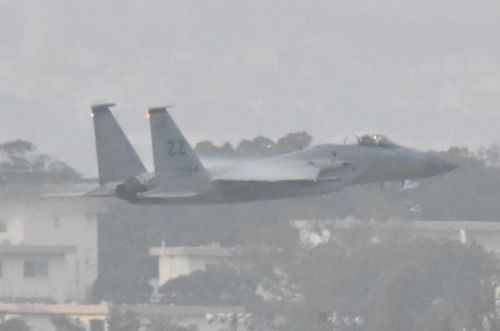
June 12, 2018 Ryukyu Shimpo
In the early morning on June 11, a U.S. F-15 fighter aircraft from Kadena Air Base crashed in the ocean to the south of Okinawa Island.
Residents living in the vicinity of the base have been reminded again of the danger to which they are neighbors.
Those living their usual daily lives below heard a resounding roar from the U.S. military aircraft overhead, which aroused their fear of repeating aircraft accidents.
The somber mood left in the wake of the accident hung heavy in the areas surrounding the base.
Nearby residents are saying things such as, “They are dangerous after all,” and “What if one comes down in a residential district?”
Watching a television program covering the accident, a 69-year-old woman living in Yara, Kadena Town said, “Because they’re always flying I come to think that it’s okay, but I was reminded that they are dangerous after all.”
She remembers an accident from her very early childhood when a U.S. military aerial tanker crashed in Yara.
With a grimace, she said that at the time of the crash, “There was a sound like a bomb detonating; I didn’t know where the U.S. military craft had fallen.” She mentioned, “Each time an accident occurs I get worried.”
At around 6:00 a.m. on June 11, an 84-year-old woman who lives in Minami-ku, Kadena Town heard an F-15 taking off from Kadena Air Base.
Furrowing her brow, the woman said, “I dread to think what would happen if that came down in Naha.
” She mentioned, “It was frightening at times when [North Korea] carried out nuclear tests because I wondered, ‘When will Kadena Air Base become the target?'”
With an uneasy countenance she continued: “The poor children. When I look at my grandchildren’s faces, I wonder, ‘When these children grow up will the world be a peaceful place without war and bases?'”
Fifty-two-year-old Yushin Teruya who lives in Sunabe, Chatan Town, said, “There is risk every day where we live, so unfortunately, we have actually gotten used to it.
” She emphasized, “I realize that as accidents occur, our sense of danger becomes duller. For the sake of the children we cannot grow accustomed to this.”
U.S. military aircraft fly over Chibana, Okinawa City every day.
Head of the Chibana Neighborhood Council, 57-year-old Tsuyoshi Ura, expressed that although he is relieved that there have not been casualties, he is concerned about what will happen if an aircraft comes down in a residential district.
He heard about the accident in the news.
With a sigh he said, “It would be good if the Neighborhood Council was also informed, but we were not contacted.”
(English translation by T&CT and Erin Jones)
Go to Japanese
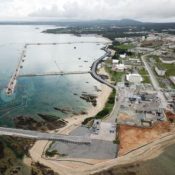
June 8, 2018 Ryukyu Shimpo
The Japanese government is making arrangements for land reclamation work in Henoko, as part of construction of the replacement facility for Futenma Air Station.
Although the government planned to start depositing soil into the ocean in July, this is being pushed back to mid-August. It is being delayed due to the government handling changes to its coral transplantation plans, among other things.
Under the Okinawa Prefecture Red Soil Prevention Ordinance, the Okinawa Defense Bureau (ODB) will soon notify the Okinawa Prefectural Government (OPG) of the date on which it will start depositing soil.
Even following Governor Takeshi Onaga revoking his predecessor’s approval of the land reclamation permit, the Japanese government is advancing preparations toward depositing soil.
This makes how the OPG will handle these matters from here on out the focal point.
The spot planned for soil deposition is on the south side of Cape Henoko, enclosed by the K4, N3, and N5 seawalls.
Already the N3 and N5 seawalls have reached their arranged lengths, but the K4 seawall is still under construction.
It is estimated that the work enclosing these seawalls will be completed in mid-July.
In April the ODB found a colony of scarce Stylaraea punctata coral in the vicinity of the construction area.
When the governor did not give his approval to transplant the coral, the ODB changed its approach to proceeding with construction without transplanting the coral.
According to the ODB, now the process is being delayed by conservation measures that dimish the amount of stone that can be deposited in the ocean per day, and that require extra handling such as increasing the layers of silt curtains.
However, in late May the ODB began making arrangements with the OPG prior to soil depositing in order to fulfill requirements under the Okinawa Prefecture Red Soil Prevention Ordinance.
The Ordinance requires the ODB to notify the OPG 45 days prior to beginning operations.
It seems that the ODB will provide notification next week at the earliest regarding the commencement of operations.
In an interview on June 7, Chief Cabinet Secretary Yoshihide Suga spoke about the timeframe from soil deposits.
He said, “In order to complete relocation as soon as possible, we will proceed steadily while considering the natural environment and citizens’ lives.”
(English translation by T&CT and Erin Jones)
Go to Japanese
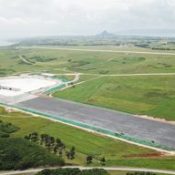
June 7, 2018 Ryukyu Shimpo
At Ie Jima Auxiliary Airfield in Ie Village, expansion work is proceeding on the “LHD deck” airstrip, which simulates the deck of an amphibious assault ship.
On June 6, the Ryukyu Shimpo used drone aerial photography to check in on this airstrip and the construction of a parking apron scheduled for installation southeast of the airstrip.
The airstrip and parking apron appear white because heat-resistant concrete is being used to deal with the exhaust heat from U.S. military CV-22 Osprey vertical take-off and landing transport aircraft and F-35 stealth fighter aircraft, which are expected to be used there. An official involved with this expansion said, “Installation of the concrete is almost done.”
Regarding the completion of the airstrip, the Okinawa Defense Bureau holds that, “According to the U.S. military, it will take until this November or later.”
In the future, the ODB plans to level the land and cover it with asphalt to prevent foreign substances from interfering with the aircraft engines.
A concerned official said, “There is no facility related to refueling; it has not been completed yet.”
A representative of Ie Village stated, “We repeatedly made requests through the Defense Bureau to halt construction.
It is regrettable that construction is proceeding.”
(English translation by T&CT and Megumi Chibana)
Go to Japanese

June 7, 2018 Ryukyu Shimpo Digital Edition
With a 155-km fastball and good slugging power, two-way prospect Joey O’Brien, 20, from Okinawa Prefectural Kitagusuku High School, and more recently the College of Southern Nevada, was drafted by the Seattle Mariners in the sixth round of the MLB draft held from June 4-6. O’Brien went to the Mariners 178th overall.
O’Brien was born in America to a Japanese mother, Akemi Sunagawa, and an American father, John, before moving to Okinawa when he was three.
Growing up in Ishigaki, O’Brien started playing baseball with Atta Friends while at Kitagusuku Elementary, and continued playing on the school teams at both Kitagusuku Middle and High Schools.
After graduating high school, he continued onto the College of Southern Nevada with an eye of making the Major Leagues.
At 188 cm tall and weighing 97 km, O’Brien both throws and bats right-handed. Last year, O’Brien’s younger brother, Richard Sunagawa (Okinawa Shogaku High School), was selected 3rd in Japan’s developmental draft by the Fukuoka SoftBank Hawks.
O’Brien said, “Last year, [being drafted] didn’t seem real, but it has been a dream for me since I was a little kid.
I will do my best to climb up onto a major league mound in the next 2-3 years.
Since I am putting to use the skills I developed in Japan, I want to thank all of my past teammates.”
(English translation by T&CT and Sam Grieb)
Go to Japanese
June 7, 2018 Ryukyu Shimpo
It was announced June 6 that Japan and the U.S. are discussing a proposal to solve an ongoing issue where the U.S. has refused to pay damages to the surviving family of the woman who was raped and murdered by a civilian contractor working on a U.S. military base in 2016.
The proposal concerns a special measure where the U.S. would pay damages to the family, and if the amount does not satisfy what is decided in the final court decision, Japan will cover the remainder as relief money.
The first and foremost issue regarding the payment of damages has to do with the defendant, who is currently appealing a life sentence.
There is a disagreement between Japan and the U.S. on the interpretation of one of the clauses in the Status of Forces Agreement (SOFA), and while progress has been slow, the plan is to put the decision in the hands of the leaders at Japan’s Ministry of Defense.
In the lawsuit, the family of the victim has demanded financial compensation as outlined in SOFA, however the U.S. government is maintain that since the defendant was hired by a private company contracted by the U.S. military, he was an “indirect hire,” and thus outside the scope of what qualifies for financial compensation.
Meanwhile, Japan argues that even an indirect hire is within scope, creating a discrepancy between the two sides.
Therefore, Japan is exploring a way to seek damages outside of the framework of SOFA, for which they are demanding the U.S. pay.
In cases involving the U.S. military outside of official military business, there is a system for the payment of civil damages outlined in the Special Action Committee on Okinawa (SACO) that says in cases where the U.S. is required to pay civil damages but, “where payment by the US Government did not satisfy the full amount awarded by a final court judgment,” the Japanese government will make a payment to cover the difference.
However, if the U.S. refuses to pay outright, Japan is unable to cover the difference. Japan is discussing a proposal to use a similar system to make the U.S. pay, and to then cover any amount deemed insufficient.
Defense Minister Itsunori Onodera received a request from the Liberal Democratic Party (LDP) coalition at the Okinawa Prefectural Assembly demanding quick payment of civil damages, to which he responded, stressing, “This case requires an agreement from the U.S.” Additionally, he said that he would be approaching U.S. Defense Secretary Jim Mattis and U.S. Ambassador to Japan William Hagerty and that he, “do everything in my power to obtain their cooperation.”
(English translation by T&CT and Sam Grieb)
Go to Japanese
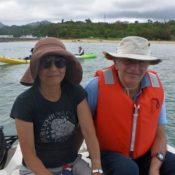
June 6, 2018 Ryukyu Shimpo
On June 5, former Canadian diplomat who currently lives in Vancouver, Terry Greenberg, 72, and his wife Yoko Oikawa, 59, attended an at-sea protest for the first time.
The purpose of this protest was to prevent the new base construction that is taking place in Henoko, Nago City. During the protest, Mr. Greenberg personally witnessed the citizens standing face to face with the guards across an oil fence.
He said, “I’m shocked by the outrageousness of the Japanese people feuding amongst each other over strengthening the U.S. military forces.
” Regarding forcing through with the base construction that opposes the will of the Okinawan citizens, he said that it is “Nothing more than discrimination and bullying of Okinawa” by both the Japanese and U.S. governments.
Mr. Greenberg had worked for the Canadian Ministry of Affairs and had resided in Osaka and Yokohama for a total of 12 years.
After he retired, he took part in support activities for Palestinians since they are related to his own Jewish roots.
Last year, when he and Yoko had visited Okinawa, he was outraged by the new Henoko base construction that would lead to the heavy military base burden that continues even after the war and strengthening military forces.
Following this, he decided to raise his own voice via this protest activity.
Mr. Greenberg pointed out that “The greatest purpose of the new base construction is to strengthen the U.S. military forces.
It’s definitely not to protect Okinawa or Japan.
” He also said that the Japanese government should “Listen to the voices of the Okinawan citizens more than the U.S.”
(English translation by T&CT and Chelsea Ashimine)
Go to Japanese
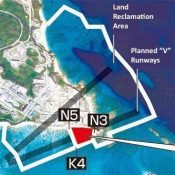
June 5, 2018 Ryukyu Shimpo
By Yuri Shimizu
On June 4, the Okinawa Defense Bureau (ODB) began notification procedures as set forth in the Okinawa Prefecture Red Soil Prevention Ordinance, which is necessary to perform before depositing soil in the ocean. These soil deposits are part of construction in Henoko, Nago City, of a replacement facility for Futenma Air Station. On May 29, the ODB submitted official documents to the Okinawa Prefectural Government (OPG) setting out its methods for carrying out land reclamation plans and red soil outflow countermeasures, among other things. When the OPG finishes its formal examination of the ODB’s methods, the ODB will report its countermeasures to soil run-off and related things to the OPG. Following this, once the OPG finishes its content review, the ODB can begin depositing soil in the ocean. The movement towards depositing soil is gearing up.
If preparations go forward at a typical speed, the formalities will be finished at the soonest by mid-June, and at the latest by late July. There is no other required procedure from within Okinawa for land reclamation soil depositing. If the seawalls surrounding the land reclamation area are completed, the stage will be set for soil to be deposited.
The OPG does not have the power to grant authorization based on Prefecture Red Soil Prevention Ordinance. On top of examining and reviewing notifications from the business operators interacting with the Ordinance, when necessary, the OPG can order negotiations of the contents and alterations to the plans.
This Ordinance requires notification 45 days prior to the commencement of any operations.
However, operations can commence even within 45 days of the OPG finishing its review. This generally takes the OPG one to two weeks to complete.
The countermeasures to red soil outflow that the ODB submitted at this time applies to the ocean section enclosed by the K4, N3, and N5 seawalls on the south side of Cape Henoko.
In order for the ODB to prevent red soil outflow, the countermeasures establish that when muddy water is emitted in the land reclamation area where sand will be deposited, the mass of floating particles must remain below 25 milligrams per one liter of water, even lower than the Prefecture Ordinance standard of 200 milligrams per one liter of water. On May 28 the Environmental Oversight Committee reviewed these terms, and the members consented to them. The next day, the ODB submitted its documents to the OPG.
Director Hiroshi Ohama of the OPG’s Environment Department said that even in the stages prior to adjustments, “Though we can’t choose whether or not to authorize the procedures, if we are notified, we must closely examine what we are given.”
(English translation by T&CT and Erin Jones)
Go to Japanese
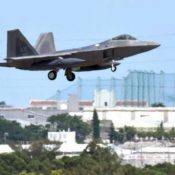
May 31, 2018 Ryukyu Shimpo
U.S. F-22 Raptor stealth fighters were first deployed to Okinawa in 2007, and have again been temporarily deployed to Kadena Air Base. Following deployment, the number of noise occurrences in neighboring municipalities doubled, and complaints from residents increased as well. The U.S. Air Force’s newest stealth fighters, F-35As, had been provisionally deployed for about six months to Kadena Air Base, and just returned to the United States in early May. Consecutive aircraft deployments raise concerns about intensified noise and increased complaints from surrounding municipalities.
At the Roadside Station (Michi no Eki) Kadena around 3:10 p.m., four F-22 fighter planes appeared above Kadena Air Base, turned around, flew through the sky, and landed. Staff of Kadena Town and Chatan Town gathered and watched after receiving a report about F-22 provisional deployment from the Okinawa Defense Bureau.
Portable noise measuring instruments brought by a staff member recorded the F-22s’ noise at 91.4 decibels. Two aircraft landed around 3:40 p.m., and four more aircraft landed around 7:10 p.m.
Around 3:40 p.m., approximately 30 minutes after the arrival of F-22 fighter planes, F-15 fighter jets took off from Kadena Air Base. The highest noise recorded on this day was a figure of 101.1 decibels at Yara in Kadena Town. Tourists who were visiting the Roadside Station stopped talking because of the noise and stood still, frowning.
President Sachio Kuwae of the Three-City/Town Liaison Council on U.S. Military Kadena Air Base (Three-Party Council), which is comprised of representatives from Okinawa City, Kadena Town, and Chatan Town, spoke in regard to aircraft deployments and how they increase the burden on residents of the surrounding areas. Kuwae emphasized, “The U.S. military must adhere firmly to the promise made by Japan and the United States.” On a representative of the city, he shared his thoughts about watching over flights routes and early morning and late-night takeoffs and landings.
Mayor Masaharu Noguni of Chatan Town angrily responded to this new provisional deployment, saying, “The U.S. military is audaciously bringing in more aircraft from outside. The burden is not reduced at all.” He was enraged because the Japanese government is touting its actions as base burden reduction while performing the opposite. Chatan Town received a notice from the Okinawa Defense Bureau about the provisional deployment of F-22 aircraft about three hours before the aircraft arrived. He strongly criticized the correspondence from the Defense Bureau and the U.S. military, saying, “Just prior to arrival is too late to communicate.”
(English translation by T&CT and Megumi Chibana)
Go to Japanese
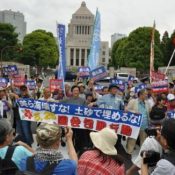
May 27, 2018 Ryukyu Shimpo
A large-scale citizens’ rally encircling the National Diet called “Don’t Destroy the Beautiful Ocean, Don’t Fill it with Sand” met on May 26, calling for abandonment of Futenma replacement facility construction in Henoko, Nago City. The rally was organized by the Stop! Henoko Land Reclamation Diet Encirclement Action Committee and was held in the area around the National Diet Building in Chiyoda Ward, Tokyo. This is the 6th National Diet encirclement action to protest construction of the new base in Henoko that has taken place since June last year. According to the organizers, about 10,000 people came to encircle the Diet Building and to put their energy into messages such as, “Don’t fill the ocean in Henoko with sand,” and “We don’t need a government that destroys nature.”
The participants pointed out that land reclamation and construction of seawalls for the new base are progressing, and that it is possible soil will be deposited into the ocean in June. Shinsaku Nohira of the action committee pointed out that the government has been hiding information, while the ocean floor where the base is to be constructed has been identified as infirm. He said, “The keywords are soft ground and active fault. A base cannot be built on soft ground. Don’t waste the taxpayers’ money. The government should not lie.”
Representative Hiroshi Ashitomi of the Helicopter Base Objection Association, members of Okinawan citizens’ groups, and Diet members belonging to opposition parties grasped microphones in front of the main entrance to the Diet Building and raised their objections to the government advancing construction work while ignoring popular will against construction. Citizens hoisted blue placards, handmade banners and flags with individual objections and phrases such as “Don’t bury the beautiful ocean.”
All-Okinawa Kaigi (All-Okinawa Coalition) executive director and former teacher Ryuji Yamamoto said he thinks it is problematic that some facilities in the vicinity of the new base site, such as the National Institute of Technology, Okinawa College, exceed the height restrictions specified in the U.S. Unified Facilities Criteria, yet these facilities are being made exceptions. Touching on the incident in which a window part from a U.S. military helicopter fell onto the grounds of Futenma Daini Elementary School in Ginowan City, Yamamoto said, “I don’t want exceptions to be made where children’s lives are concerned.”
House of Councillors member Yoichi Iha, one of the opposition party Diet members from Okinawa, said, “There are no alternative feeding grounds for the dugong. We cannot let land reclamation happen.”
(English translation by T&CT and Erin Jones)
Go to Japanese
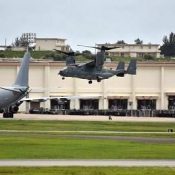
June 4, 2018 Ryukyu Shimpo Digital Edition
Three U.S. Air Force CV-22 Osprey transport aircraft stationed at Yokota Air Base landed one after the other at Kadena Air Base in Okinawa in the afternoon June 4. This is the first time that the CV-22 has come to Okinawa.
The first CV-22 landed at 2:41 p.m., the second 10 minutes later, and the third at around 3:30 p.m.
That same morning, five CV-22 aircraft departed from Yokota Air Base, however only three were confirmed to have landed at Kadena. At around 3:00 p.m. two Ospreys that appeared to belong to the U.S. military made emergency landings at Amami Airport in Kagoshima. They appear to be the two remaining aircraft seen departing from Yokota earlier that day.
Defense Minister Itsunori Onodera confirmed at a press conference in the afternoon June 4 that one of the CV-22s that landed at Amami Airport did so after experiencing trouble in transit. They are still trying to confirm more details. Onodera explained that the emergency landing at Amami “did not cause” and delays or damage to civilian aircraft, and that, “We have dispatched Ministry of Defense employees to the airport to gather information.”
In Chatan, and e-mail was sent by the Okinawa Defense Bureau (ODB) around 2:50 p.m., after the first Osprey had landed. The message explained, “We are confirming that an Osprey landed at Kadena Air Base at around 2:40 p.m. They are only making a stop on route to another destination.”
It is unclear how many aircraft will arrive in total, or how long they will be stationed at Kadena. Okinawa City and the town of Kadena were also notified by the ODB at the same time.
The five CV-22 aircraft are planned to be formally deployed at Yokota Air Base this summer.
(English translation by T&CT and Sam Grieb)
Go to Japanese
May 31, 2018 Ryukyu Shimpo
Tokyo –In a policy paper submitted by the Liberal Democratic Party (LDP) to the necessary ministries in hopes of the policy suggestions being reflected in the “Big-Boned Policy,” a set of policy guidelines to determine economic and fiscal management, it was learned on May 30 that the sentence “A plan to improve English education with help from U.S. military in Japan,” had been edited, changing “U.S. military in Japan,” to “the U.S.” This information was disclosed by someone involved in the matter. While this seems to have been caused by an outburst of contention within the LDP, the goal is still to promote English education with help from the U.S. military, and the only thing that has changed is the language used.
The policy paper also mentions, “A direction towards continued Okinawan stimulus,” and comes close to including an item regarding a “big-boned” Okinawan stimulus.
Practically speaking, the contents of the paper are still in the investigation phase, but it is promoting a policy to make use of the U.S. military in ways such as using the colleges inside U.S. bases to improve English education.
The Foreign Affairs Ministry is already working on using the U.S. military to bolster English education, so there were calls from places like the LDP’s Special Committee on Okinawa arguing that it should be included in the policy suggestions for the “Big-Bone,” and so it was added as a revision.
However, some within the LDP argued that, “the language is too direct,” and that, “it conflicts with the relief of the burden from the bases.” With that in mind, the government officials concerned with drafting the proposal took feedback from places like the LPD prefectural chapters, and quelled the blowback by editing “U.S. military stationed in Japan,” to read only “the U.S.”
(English translation by T&CT and Sam Grieb)
Go to Japanese









 Webcam(Kokusai Street)
Webcam(Kokusai Street)


